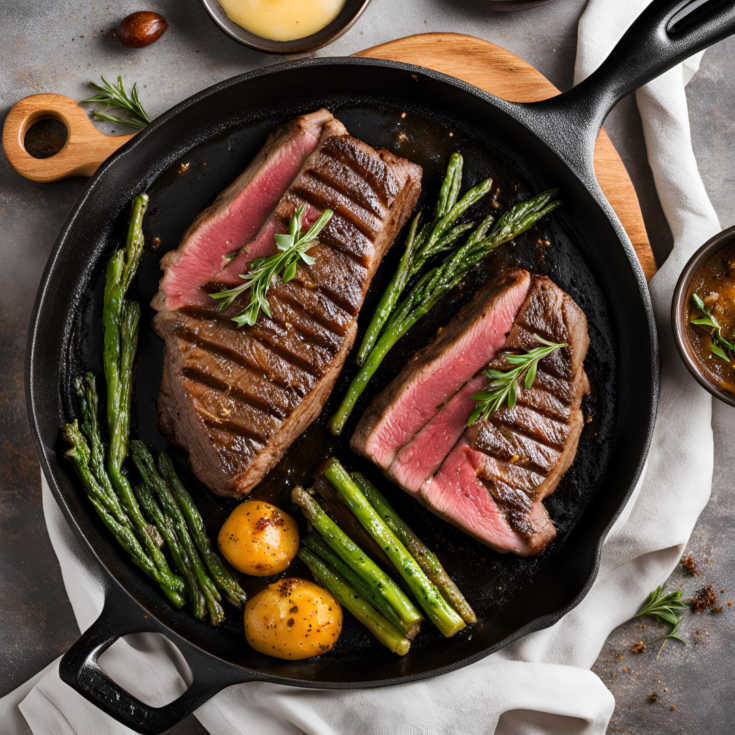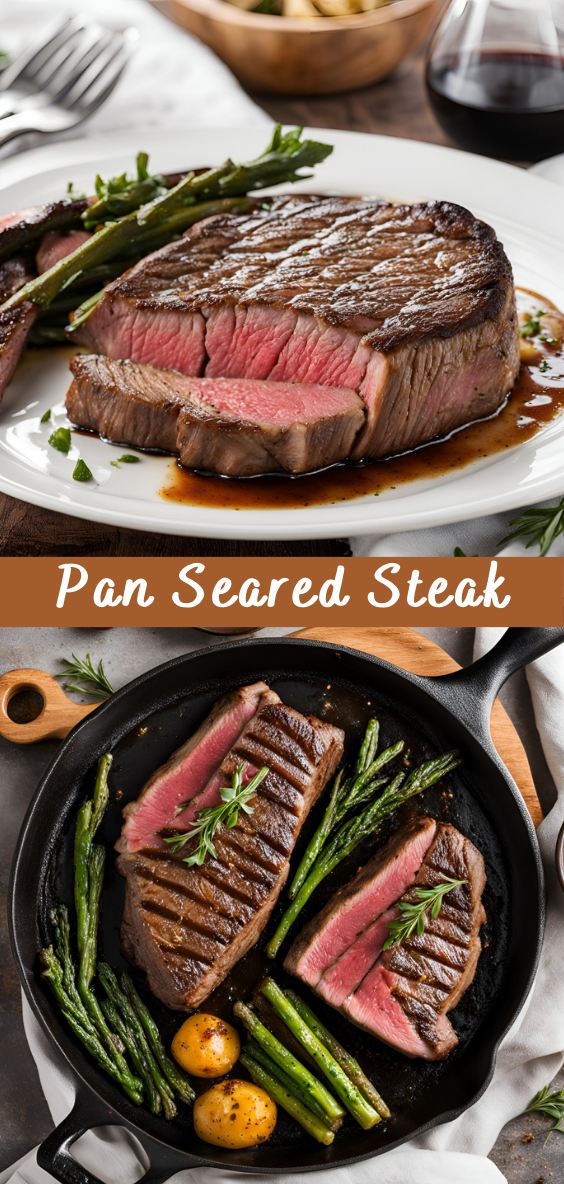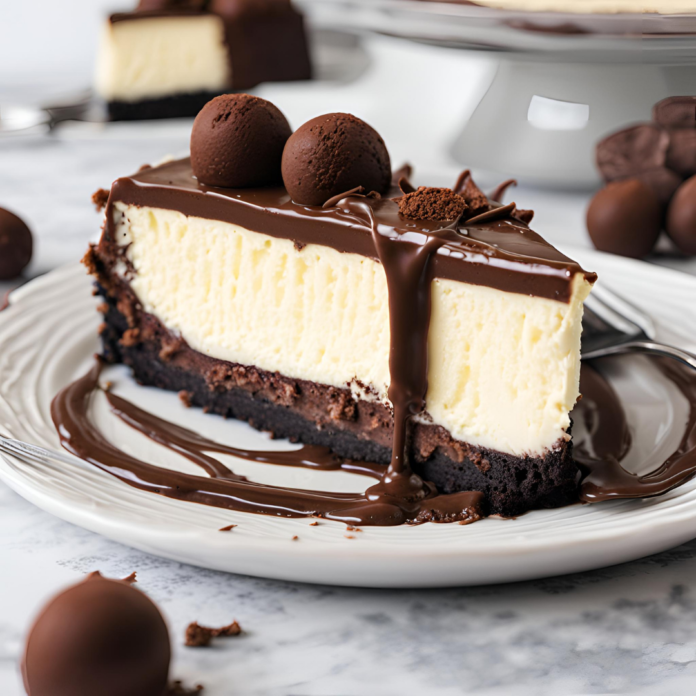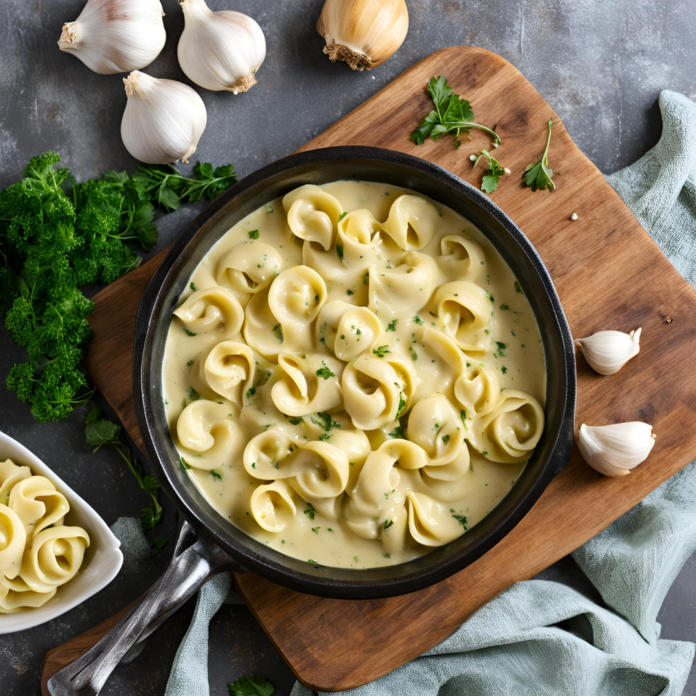Pan Seared Steak
Introduction
There’s nothing quite like a perfectly pan-seared steak. It’s juicy, flavorful, and has that irresistible crust that steak lovers crave. Whether you’re cooking for a special occasion or just treating yourself to a gourmet meal at home, pan-seared steak is a go-to dish that delivers every time. Let’s walk through the steps to create a restaurant-quality steak in the comfort of your kitchen.

Preparation
Choosing the Right Cut of Steak
When selecting a steak, go for cuts like ribeye, New York strip, or filet mignon. These cuts are tender and have the right amount of marbling, which ensures a juicy and flavorful result.
Prepping the Steak
Remove the steaks from the refrigerator about 30 minutes before cooking to allow them to come to room temperature. Pat them dry with paper towels to remove any excess moisture.
Seasoning the Steak
- Salt and Pepper: Generously season both sides of the steaks with salt and freshly ground black pepper. This is crucial for building flavor.
- Let Sit: Allow the seasoning to sit on the steak for at least 10 minutes before cooking. This helps the flavors penetrate the meat.
Cooking the Steak
Step-by-Step Instructions for Pan-Searing
- Heat the Skillet: Place a cast-iron skillet over medium-high heat and add the olive oil. Heat until the oil is shimmering and just starting to smoke.
- Add Steaks: Carefully place the steaks in the hot skillet. You should hear a loud sizzle—this means the steak is searing properly.
- Sear: Sear the steaks for about 3-4 minutes on each side for medium-rare, adjusting the time according to your desired doneness.
Achieving the Perfect Crust
- Don’t Move the Steak: Allow the steak to sear undisturbed to form a beautiful crust.
- Flip Once: Flip the steak only once to ensure even cooking and a consistent crust.
Using a Cast-Iron Skillet
Benefits of Using Cast-Iron
A cast-iron skillet retains heat exceptionally well and distributes it evenly, which is perfect for searing steaks. It also helps develop a great crust.
How to Properly Heat the Skillet
Make sure the skillet is preheated before adding the steak. This ensures that the steak sears immediately upon contact.
Basting the Steak
Importance of Basting
Basting the steak with butter and herbs during the cooking process adds an extra layer of flavor and richness.
Techniques for Basting
- Add Butter and Herbs: During the last minute of cooking, add the butter, smashed garlic, and rosemary or thyme to the skillet.
- Tilt and Baste: Tilt the skillet slightly and use a spoon to continuously baste the steaks with the melted butter and herb mixture.
Determining Doneness
Temperature Guide for Doneness
- Rare: 125°F (51°C)
- Medium-Rare: 135°F (57°C)
- Medium: 145°F (63°C)
- Medium-Well: 150°F (66°C)
- Well-Done: 160°F (71°C)
Using a Meat Thermometer
Insert an instant-read thermometer into the thickest part of the steak to check the temperature without cutting into it.
Resting the Steak
Why Resting is Crucial
Resting allows the juices to redistribute throughout the steak, ensuring a juicy bite.
How Long to Rest the Steak
Let the steak rest on a cutting board for at least 5 minutes before slicing.
Serving Suggestions
Pan-seared steak pairs well with:
- Garlic mashed potatoes
- Grilled asparagus
- A fresh green salad
- Roasted vegetables
Variations and Substitutions
Different Types of Steaks
You can use other cuts like sirloin, T-bone, or filet mignon based on your preference and availability.
Alternative Seasonings and Herbs
- Seasonings: Add a sprinkle of smoked paprika or chili powder for a different flavor profile.
- Herbs: Swap rosemary or thyme with sage or oregano for a unique taste.
Health Benefits
Nutritional Information
- Protein: Steak is an excellent source of high-quality protein.
- Iron: Red meat is rich in iron, essential for healthy blood cells.
- B Vitamins: Provides vital B vitamins, including B12, which supports nerve function.
Tips and Tricks
Cooking Hacks for Beginners
- Preheat Properly: Ensure your skillet is hot before adding the steak.
- Use Tongs: Use tongs to handle the steak without piercing it, which helps retain juices.
Common Mistakes to Avoid
- Overcrowding the Pan: Cook one steak at a time if your skillet isn’t large enough to accommodate both without touching.
- Skipping the Rest: Resting the steak is crucial for retaining its juices.
Pairing with Drinks
Best Beverages
- Red Wine: A bold Cabernet Sauvignon or a smooth Merlot complements the rich flavors of the steak.
- Beer: A dark stout or a hoppy IPA pairs well with the savory notes.
Non-Alcoholic Options
- Sparkling Water: Flavored sparkling water can provide a refreshing contrast.
- Iced Tea: A glass of iced tea, sweetened or unsweetened, is a great non-alcoholic choice.
Storing and Reheating
How to Store Leftovers
Store leftover steak in an airtight container in the refrigerator for up to 3 days.
Best Reheating Methods
Reheat the steak gently in a skillet over medium-low heat to avoid overcooking. You can also reheat it in the oven at 250°F (121°C) until warmed through.
Frequently Asked Questions
- How long does it take to cook? Cooking time depends on the thickness of the steak and your desired doneness, typically around 8-10 minutes.
- Can I use a different type of oil? Yes, you can use canola oil, avocado oil, or any high smoke-point oil.
- What if I don’t have a cast-iron skillet? A heavy stainless-steel skillet will also work well for pan-searing.
- Is this dish suitable for keto diets? Yes, pan-seared steak is keto-friendly as it is high in protein and healthy fats.
- How can I make it more flavorful? Marinate the steak in garlic, herbs, and olive oil for a few hours before cooking, or use a compound butter for basting.
Conclusion
Pan-seared steak is a simple yet impressive dish that never fails to satisfy. With the right cut of meat, proper seasoning, and a few cooking techniques, you can create a steak that’s tender, juicy, and full of flavor. Whether it’s for a special occasion or a weeknight dinner, this recipe is sure to become a favorite. Give it a try and enjoy the perfect steak at home!
Pan Seared Steak

There’s nothing quite like a perfectly pan-seared steak. It’s juicy, flavorful, and has that irresistible crust that steak lovers crave. Whether you're cooking for a special occasion or just treating yourself to a gourmet meal at home, pan-seared steak is a go-to dish that delivers every time. Let’s walk through the steps to create a restaurant-quality steak in the comfort of your kitchen.
Ingredients
- 2 lbs New York Strip Steaks (2 steaks), or Ribeye or Top Sirloin Steaks (1 lb each steak, 1 1/4” thick)
- 1/2 Tbsp vegetable oil, or any high heat cooking oil like canola or extra light olive oil
- 1 1/2 tsp sea salt
- 1 tsp black pepper, freshly ground
- 2 Tbsp unsalted butter
- 2 cloves garlic, peeled and quartered
- 1 sprig fresh rosemary
Instructions
Thoroughly pat steak dry with paper towels. Just before cooking, generously season with 1 1/2 tsp salt and 1 tsp black pepper
Heat the cast iron pan until hot then add 1/2 Tbsp oil over medium-high heat, swirling to coat. Once the oil is very hot, add steaks to the skillet. Sear the steaks on the first side for 4 minutes until a brown crust has formed then flip and cook another 3-4 minutes. Using tongs, turn the steak on its sides to render the white fat and sear the edges (1-minute per edge).
Reduce heat to medium and immediately add 2 Tbsp butter, quartered garlic cloves and rosemary to the pan. Spoon the butter sauce over the steak, tilting the pan to get butter on your spoon. Continue spooning the sauce over the steak for a minute or until the steak is about 5-10 degrees from your desired doneness (the temperature will continue to rise another 5-10 degrees while steaks rest).
Transfer steak to a cutting board, loosely cover and rest 10 minutes before slicing into 1/2" strips to serve. Spoon extra butter sauce over sliced steak to serve.
Notes
Steak Doneness Chart:
Medium Rare: 145 degrees F
Medium Doneness: 160 degrees F
Well Done: 170 degrees F
Nutrition Information:
Amount Per Serving: Calories: 542



